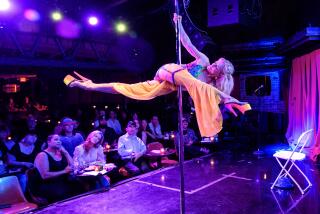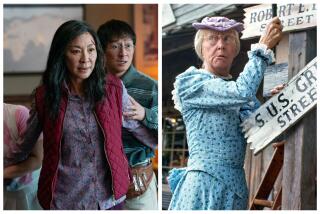Brittle Bones Can’t Stop This Dancing Grandma
- Share via
WASHINGTON — At 62, with bones weakened by osteoporosis, Joyce Clautice dances.
“I believe my muscles will be the saving grace of my bones, even if they are not as strong as a younger person,” Clautice said. “I’m strong. I’m very strong.”
The Alexandria, Va., grandmother is Ms. Senior America--a pageant winner, although she draws a distinction between this pageant and those that choose mere beauty queens. “This is inner beauty,” Clautice said. “It’s not a physical thing.”
Clautice won the title last fall in Las Vegas partly on her performance in the talent segment of the contest. She did a short ballet piece to the music of “Chariots of Fire,” the 1981 Oscar-winning movie about the athletes who ran for Britain in the 1924 Paris Olympics.
“If you could see my little leaps --I do nine of them,” Clautice said. “That must have been spectacular for the audience.”
As Ms. Senior America, Clautice is using her celebrity status to promote two causes--the value of exercise and the need for postmenopausal women to be examined for osteoporosis. She knows both firsthand.
She also knows the risk she faces, because a bone density check three years ago found her bones were as fragile as an 80-year-old woman’s.
She could have seen the brittle bone disease coming, because she had the risk factors, Clautice said. She is relatively small--around 5 feet 2 inches tall, and light-framed. She began menopause prematurely, at 42, thus losing estrogen, which protects bone strength. And her mother had osteoporosis.
Clautice responded to her diagnosis by starting hormone replacement therapy and drug treatment.
She refuses to let osteoporosis be a barrier to being physically active. “Mental outlook can overcome a lot of our physical problems,” she said.
Clautice does aerobics, weight training and skiing, besides playing racquetball and tennis. She kept up with lessons on interpretive dance for almost 30 years, switching from classroom training to individual practice about two years ago when her dance teacher retired.
People with osteoporosis have to worry about injury they could suffer in a fall, although Clautice keeps her worries in check. “If I fall, I know how to be resilient,” she said. “But I have a firm outlook that’s not going to happen.”
Experts differ, however, on how far women with osteoporosis can go in following Clautice’s example. Two scientists agree on the value of exercise, but one is concerned about those ballet moves.
“While she may be able to leap across the stage, another woman trying to emulate her might very well fall and fracture a hip,” said research physiologist Barbara Drinkwater of Pacific Medical Center in Seattle. “There are some women who have such fragile bones that lifting a heavy object can cause vertebral fractures.”
Exercise is less valuable than hormone and drug treatment in countering osteoporosis, Drinkwater said. But exercise also keeps muscles and the circulatory system in good shape, so it provides overall benefits that help women with osteoporosis continue vigorous lives, she said. For those who face the risk of a crippling fracture from a fall, walking is a safe activity, she said.
Despite also being concerned about the risks of falling, researcher Miriam Nelson of Tufts University in Boston takes a less conservative approach to Clautice’s activities.
“If she loves ballet and is careful about training technique and is taking good care of herself in terms of nutrition and other things, she should keep doing it,” said Nelson, author of the book “Strong Women, Strong Bones.”
“If it’s something you really love, I don’t think you can remove it from somebody.”
More to Read
Go beyond the scoreboard
Get the latest on L.A.'s teams in the daily Sports Report newsletter.
You may occasionally receive promotional content from the Los Angeles Times.










